Myanmar coup protests grow – in pictures Police stand guard by their vehicles as protesters rally against the military coup in Naypyidaw, Myanmar. Photograph: Reuters
It’s possible that I shall make an ass of myself. But in that case one can always get out of it with a little dialectic. I have, of course, so worded my proposition as to be right either way (K.Marx, Letter to F.Engels on the Indian Mutiny)
Monday, February 08, 2021
FEBRUARY 8, 2021 / 10:01 AM / AFP
Yangon — Martial law was declared in parts of Myanmar's second largest city Mandalay Monday, after hundreds of thousands rallied across the country against the coup and the military issued a stern warning against further protests. The orders cover seven townships in Mandalay, banning people from protesting or gathering in groups of more than five, and a curfew will run from 8 pm until 4 am, the general administration department said in a statement.
A similar declaration has been made in a township in Ayeyarwaddy further south and announcements concerning other localities are expected to trickle out tonight.
"This order is applied until further notice," a Mandalay township statement said.
"Some people... are behaving in a worrying way that can harm the safety of public and law enforcement. Such behaviors can affect stability, safety of people, law enforcement, and peaceful existence of villages and could create riots, that's why this order bans gathering, speaking in public, protest by using vehicles, rallies," the statement said.
"Action must be taken"
The junta has so far refrained from using deadly force against the demonstrations sweeping most of the country, but with pressure building riot police fired water cannon in an attempt to disperse thousands gathered in Naypyidaw, and there were threats of greater force.
The military last week detained elected leader Aung San Suu Kyi and dozens of other members of her National League for Democracy party, ending a decade of partial civilian rule and triggering international condemnation.
In the face of an increasingly bold wave of defiance, state broadcaster MRTV warned that opposition to the junta was unlawful and signaled a potential crackdown.
"Action must be taken according to the law with effective steps against offenses which disturb, prevent and destroy the state's stability, public safety and the rule of law," said a statement read by an announcer on the channel.
Three-finger defiance
Tens of thousands of people overcame a nationwide internet blockade to rally over the weekend in the first major outpourings of opposition to the coup.
The movement built on Monday, with thousands of protesters holding three fingers into the sky — a defiant gesture borrowed from The Hunger Games movie series — gathering across the country and the start of a nationwide strike. In Yangon, the nation's commercial capital, crowds spilled onto the city's main roads, immobilizing traffic and dwarfing the previous day's rally.
 Protesters flash the three-fingered salute, a protest gesture borrowed from the Hunger Games movies, as they march against the military rule of their country in Mandalay, Myanmar, February 8, 2021.AP
Protesters flash the three-fingered salute, a protest gesture borrowed from the Hunger Games movies, as they march against the military rule of their country in Mandalay, Myanmar, February 8, 2021.AP"Down with military dictatorship" and "release Daw Aung San Suu Kyi and arrested people," protesters chanted, flashing the three-finger salute as car horns were honked in support.
Calls for a nationwide strike gathered momentum over the weekend, with textile workers, civil servants and railway employees walking out of work in the commercial hub.
"This is a work day, but we aren't going to work even if our salary will be cut," one protester, 28-year-old garment factory worker Hnin Thazin, told AFP.
Construction worker Chit Min, 18, joined the Yangon rally, saying his loyalty to Suu Kyi outweighed concerns about his financial situation.
"I am jobless now for a week because of the military coup, and I am worried for my survival," he told AFP.
Similarly large crowds marched in Mandalay, the country's second-largest city, many clutching photos of Suu Kyi and waving the red flags of her party.

Police attempted to disperse thousands of people gathered on a highway in Naypyidaw, where the deposed leader is believed to be detained. Water cannon were fired into the crowd, injuring at least two demonstrators, according to a photographer on the scene.
Police reportedly put a sign in a roadway warning that security forces could use live ammunition if protesters got past the third of three lines of officers in the city Naypyitaw.
Huge rallies were reported across much of the country, from Muse on the Chinese border to the southern cities of Dawei and Hpa-an. Protesters started to disperse in the early evening.
International pressure post-coup
Myanmar's generals detained Suu Kyi, 75, and other top NLD leaders in pre-dawn raids last Monday, justifying the coup by claiming fraud in last November's elections, which the party won in a landslide.
The junta proclaimed a one-year state of emergency, promising to hold fresh elections after that without offering any precise timeframe.
U.S. President Joe Biden has led global calls for the generals to relinquish power.
Pope Francis on Monday called for the prompt release of imprisoned political leaders.
"The path to democracy undertaken in recent years was brusquely interrupted by last week's coup d'etat," he told a gathering of diplomats. "This has led to the imprisonment of different political leaders, who I hope will be promptly released as a sign of encouragement for a sincere dialogue."
South East Asian lawmakers have also urged Myanmar's military to respect the people's rights to protest.
"As peaceful demonstrations grow, the risk of violence is real. We all know what the Myanmar army is capable of: mass atrocities, killing of civilians, enforced disappearances, torture, and arbitrary arrests, among others," Tom Villarin from ASEAN Parliamentarians for Human Rights said.
First published on February 8, 2021
© 2021 AFP. All Rights Reserved.
Senior General Min Aung Hlaing says an election will be held and power handed to winning party, in a rare national address, as anti-coup protesters hit streets nationwide.
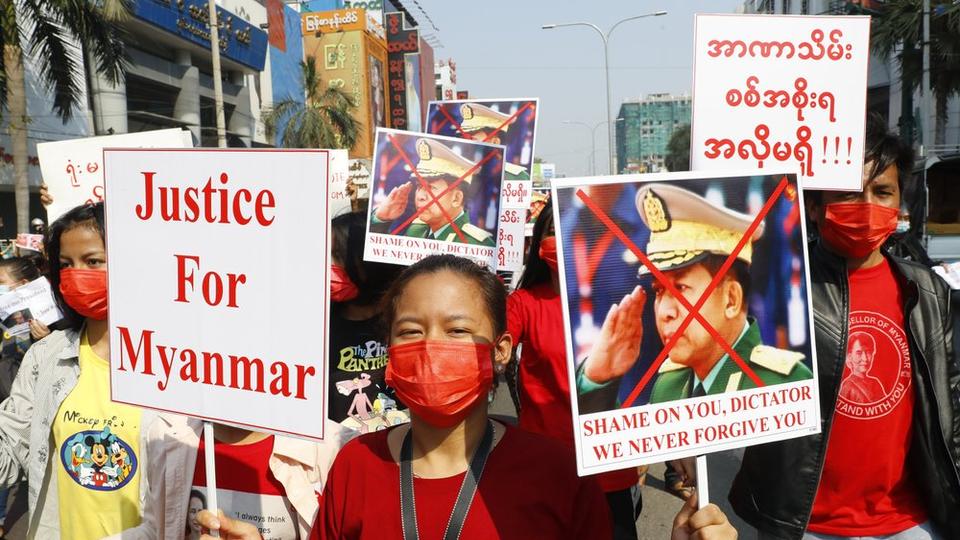
Myanmar's junta leader has called on the public to prioritise facts and not feelings, and said an election would be held and power handed to the winning party, in a rare national address, as anti-coup protests took place nationwide on the third day in a row.
Senior General Min Aung Hlaing, in his first address since a coup a week ago, said on Monday the junta was different to previous military governments and that the campaigning in a vote last November had not been fair.
Suitable ministers were selected, he said, adding foreign policy would remain unchanged and countries would be encouraged to invest in Myanmar.
He reiterated there were irregularities in last year's election that were ignored and said no organisation was above the law. He made no mention of ousted leader Aung San Suu Kyi.
READ MORE: Mass protests against army coup hit Myanmar for second day
Martial law imposed
Martial law was declared in parts of Myanmar's second largest city Mandalay on Monday, after hundreds of thousands rallied across the country against the coup and the military issued a stern warning against further protests.
The orders cover seven townships in Mandalay, banning people from protesting or gathering in groups of more than five, and a curfew will run from 8 pm until 4 am (local time), the general administration department said in a statement.
A similar declaration has been made in a township in Ayeyarwaddy further south and announcements concerning other localities are expected to trickle out tonight.
"This order is applied until further notice," one Mandalay township statement said.
"Some people ... are behaving in a worrying way that can harm the safety of public and law enforcement. Such behaviours can affect stability, the safety of people, law enforcement, and peaceful existence of villages and could create riots, that's why this order bans gathering, speaking in public, protest by using vehicles, rallies," the statement said.
READ MORE: Myanmar army blocks internet as thousands protest against coup
Opposition to junta called illegal
The junta has so far refrained from using deadly force against the demonstrations sweeping most of the country, but with pressure building riot police fired water cannon in an attempt to disperse thousands gathered in Naypyidaw.
The military last week detained Suu Kyi and dozens of other members of her National League for Democracy party, ending a decade of partial civilian rule and triggering international condemnation.
In the face of an increasingly bold wave of defiance, state broadcaster MRTV warned that opposition to the junta was unlawful and signalled a potential crackdown.
READ MORE: Myanmar military junta plans probe of last year's election won by Suu Kyi
Anti-coup protests swell
Police fired a water cannon at hundreds of protesters in Myanmar's capital who are demanding the military hand power back to elected officials, as demonstrations against last week’s coup intensified and spread to more parts of the country.
The demonstrations in Naypyitaw, ongoing for several days, are especially significant since the city, whose population includes many civil servants and their families, has no tradition of protest and has a heavy military presence.
A protest also swelled at a major downtown intersection in the country’s largest city, Yangon, with people chanting slogans, raising a three-finger salute that is a symbol of resistance and carrying placards saying, "Reject the military coup" and "Justice for Myanmar."
"Police used water cannons to clear the (road)," Naypyidaw resident Kyaw Kyaw, who had joined the protest, told AFP news agency.
A photographer also witnessed the incident, the first reported use of water cannons against protesters since rallies kicked off three days ago.
"We are joining the protest to end the military dictatorship," Kyaw Kyaw said.
Rallies over the weekend were largely peaceful, but local media reported that in the southeastern city of Myawaddy, police fired warning shots in the air to disperse a group of protesters.
'Reject Military Coup'
Thousands of anti-coup protesters marched in Myanmar's biggest city of Yangon on the third day of street demonstrations.
A group of saffron-robed monks marched in the vanguard of the protest with workers and students. They flew multicoloured Buddhist flags alongside red banners in the colour of Suu Kyi's NLD, witnesses said.
"Release Our Leaders, Respect Our Votes, Reject Military Coup," said one sign.
Many protesters wore black.
In Myanmar's second largest city, Mandalay, more than a thousand had also gathered by mid morning.
And hundreds were seen turning out in the capital of Naypyidaw, riding around on motorbikes and honking car horns, while major rallies were also reported in other towns.
Over the weekend tens of thousands of people massed on the streets across Myanmar in the biggest protests since the coup.
READ MORE: Myanmar military junta plans probe of last year's election won by Suu Kyi
Military coup
Myanmar's generals have justified the coup by claiming fraud in last November's elections, which the NLD won in a landslide.
The junta has proclaimed a one-year state of emergency, and promised to then hold fresh elections, without offering any precise timeframe.
The coup has triggered widespread international condemnation, although neighbouring China has declined to criticise the generals.
US President Joe Biden has been leading the calls for the generals to relinquish power.
Pope Francis on Sunday also expressed "solidarity with the people of Myanmar," urging the army to work towards "democratic coexistence."
Britain and the European Union requested on Monday that the United Nations Human Rights Council hold a special session in response to the ongoing political crisis.
The call comes came a week after Myanmar's generals conducted a coup in the country.
"The United Kingdom would like to inform all colleagues that together with the European Union, we have submitted a request for a special session on the human rights implications of the crisis in Myanmar," Julian Braithwaite, Britain's ambassador in Geneva, told a council organisational meeting.
READ MORE: UN Security Council expresses 'deep concern' after
Generation Z and millennial relationships culture are making a strong showing in the signs.

As people fill the streets for the third day in Myanmar to reject a military coup, some young demonstrators are waving signs that break with the country's more traditional protest messages.
In contrast to earlier opposition movements, this generation has grown up in a freer country, with better access to the internet and knowledge of Western culture and memes that go with it.
We've put together pictures of some of the witty, self-deprecating and occasionally naughty humour Gen Z (usually aged under 24) protesters have added to their pro-democracy messages for the military leaders that seized power last week.
The military are claiming, without evidence, that the November election that returned Aung San Suu Kyi's National League for Democracy (NLD) to power was fraudulent.
Of course, being the BBC, we've had to blur out some of the more, let's say, colourful language, but the ideas are still there.
'My ex is bad but Myanmar military is worse'

Myanmar: What is happening and why?
How Facebook became the 'digital tea shop'
One sign reads "My ex is bad but Myanmar military is worse", while another humbly suggests "I don't want dictatorship, I just want boyfriend".
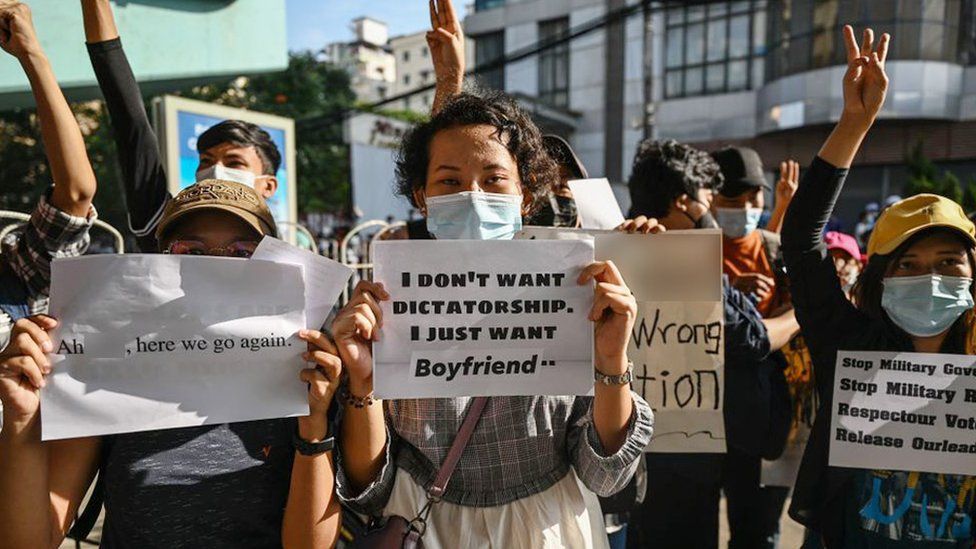
Another popular message is "Ah [expletive] here we go again", a globally popular meme often dated to a scene from 2004 video game Grand Theft Auto.
The protests are the largest since the so-called Saffron Revolution in 2007 and are seeing tens of thousands of people rally in cities across the country.
How citizens are protesting through art
On Monday police warned protesters to leave the streets or face force.
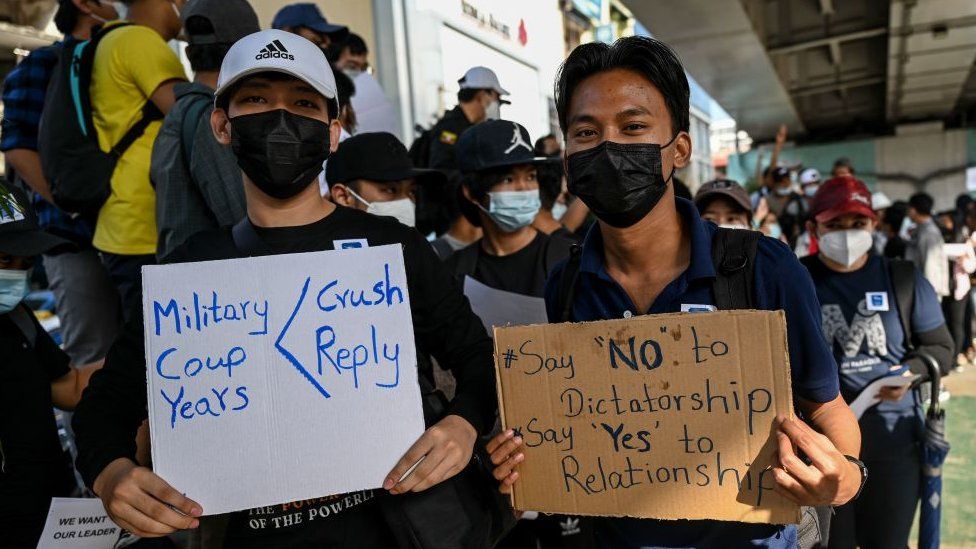
'You messed with the wrong generation'
Other protesters have been more explicit in their rejection of the coup, waving signs suggesting the military had picked a fight with the wrong people.
"You [expletive] with the wrong generation," reads one placard that could be politely re-worded as "you messed with the wrong generation".
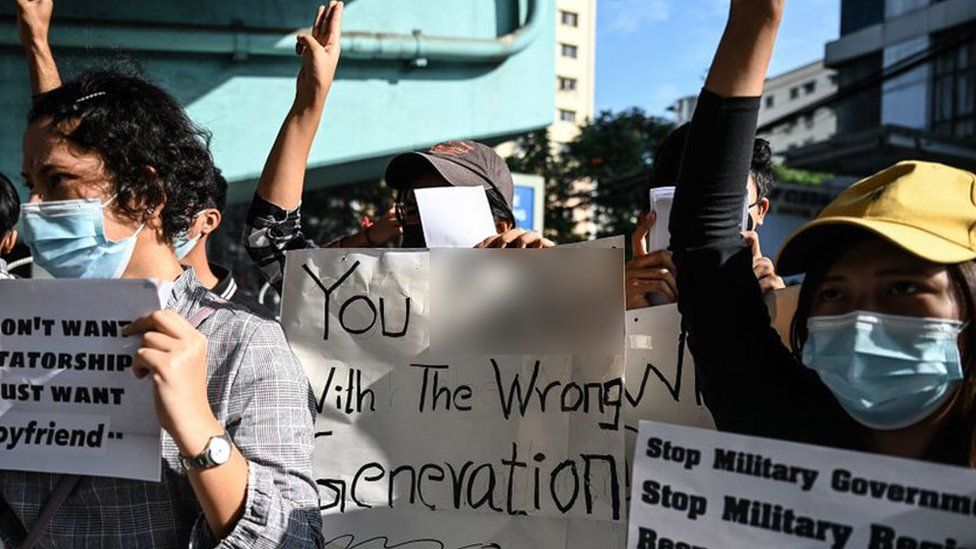
And another sign, shared on social media, drew on the widespread stereotype of millennials as a generation unable to get their lives together.
"We'll never be allowed to ruin our own future," it lamented.
'My dreams are higher than Mal's height'
Other demonstrators poked fun about the reportedly small height of the military commander Min Aung Hlaing (Mal).
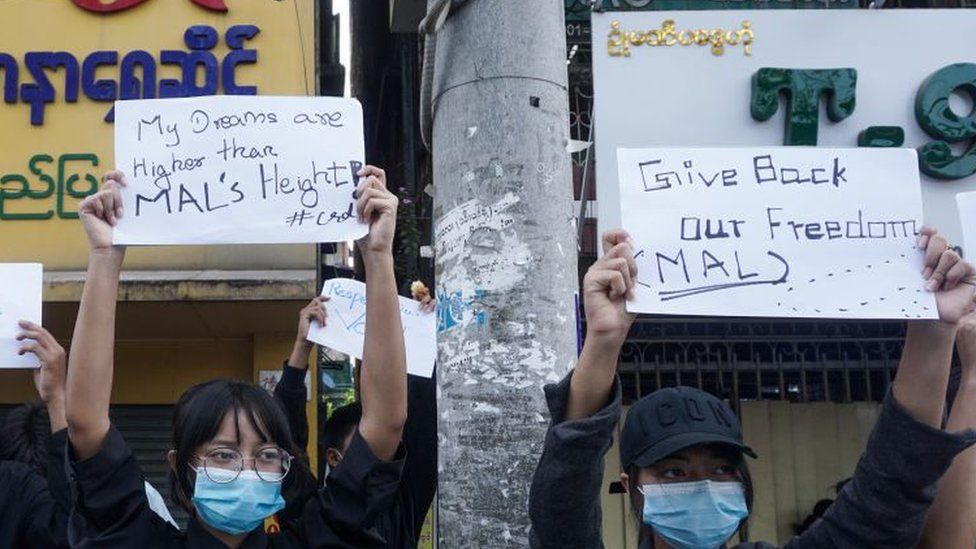
"My favourite, Ariana Grande is TALLER than [Mal]", another sign read, referring to the US pop singer who is known for her diminutive size.
American music made an appearance in another sign, which referred to rapper Cardi B's song WAP that became an instant hit and meme in 2020.
"We Are Protesting peacefully," the sign suggested.
The Oil Industry Jumps On The Low Carbon Bandwagon
Ed Hirs Contributor
Energy
Feb 8, 2021

FILE - In this Thursday, April 29, 2010 file photo,
There are two main roads leading to a low-carbon future. The first involves decreasing our combustion of fossil fuels via conservation and a switch to renewable energy.
Big fossil fuel providers are not in the business of decreasing the use of their products, which is why it is unsurprising that oil giant ExxonMobil XOM +3.9% XOM +3.9% announced its plan to accelerate carbon capture and to invest $3 billion over the next five years to advance 20 new opportunities. In doing so, they unveiled an initial plan for how they can continue to operate their core business in a carbon constrained world. Theirs is just the latest in a series of responses from oil and gas companies starting to answer this crucial question.
It’s easy to be cynical about oil companies aiming to reduce carbon emissions, but the truth is that many, including BP, Total and Occidental Petroleum have been moving in that direction for years.
The recently published BDO 2021 Energy CFO Outlook Survey is an annual, anonymous survey of chief financial officers across the energy spectrum including the industry sectors of primary energy producers—oil and gas, renewable liquids fuels, solar and wind—and the secondary energy producers, the electric utilities including generators, transmission companies, and local distribution firms. A majority of the respondents expect that the shift to renewable energy resources will accelerate through 2021—similar to their pre-pandemic view—and this is no surprise. It probably does come as a surprise to many that a supermajority of the CFOs is planning to finance renewable energy projects in 2021 including those designed to lower the carbon footprint of the company’s own activities. For example, electricity from wind and solar is used to power oilfield pumps and pipeline compressor stations.
Research and New Technologies
While oil companies typically loathe discussing proprietary research, recent filings and public announcements of investments and projects by OXY, ExxonMobil, BP, and Chevron CVX +2.2% CVX +2.2% pull back the curtain for carbon capture and the use of low carbon fuels such as renewable diesel. Universities and entrepreneurs are the source of the leading edge technologies in the press today.
In the spirit of the Orteig Prize, won by Charles Lindbergh for his flight across the Atlantic Ocean, the Carbon XPrize competition began in 2015 and has now reached the finals for ten companies. The winners will be announced in late 2021. The finalists are competing on two criteria: 1) the quantity CO2 is converted, and 2) the net value of products manufactured. Four of the finalists are U.S. companies:
· Air Company utilizes CO2 from the atmosphere to produce impurity-free ethanol for award winning vodka, fragrances, cleaning, and, potentially, rocket fuel for NASA.
· Carbon Corp. collects CO2 at the emission point to manufacture carbon nanotubes for industrial and commercial use.
· CO2Concrete converts flue gases into CO2Concrete, stable minerals used for building products, with a 75% smaller CO2 footprint than traditionally manufactured concrete. The target market includes cement plants and electricity generators that use coal or natural gas.
· Dimensional Energy focuses sunlight into a photocatalytic reactor to directly convert captured CO2 into fuel.
The other finalists from India, China, UK, and Canada represent the breadth of interest and level of competition. The lead sponsors for the competition are the U.S. utility NRG and COSIA, Canada’s Oil Sands Innovation Alliance. Prize partners range from oil companies to Google.
What’s the prize for everyone else?
The IRS issued the final regulations for “45Q” on January 6. Under 45Q, companies that capture CO2 and other greenhouse gas emissions can qualify for a tax credit of up to $50 per metric ton of carbon that is sequestered but not otherwise used or sold. If the CO2 is used in processes or the production of other products such as injection into old oilfields to increase oil production, the maximum credit is $35 per metric ton.
The federal Renewable Fuels Standards program established under the administration of President George W. Bush requires refineries to blend in renewable fuels such as ethanol, renewable diesel, and biodiesel. Economic incentives, and disincentives due to the required use of renewable fuels, are traded in the RINs market. RINs, or Renewable Identification Numbers, are assigned to renewable fuels against a benchmark of a gallon of ethanol and currently provide an economic incentive of between $1.50 per gallon for D3 (such as cellulosic biofuel) to $0.50 per gallon for D6 (total renewable fuel). In this way, refiners’ required purchases of renewable fuels provide price floors for the renewable fuels producers.

EPA's market for RINs prices EPA.GOV
State incentives vary, and California leads the way with low carbon fuel credits that are currently trading at the equivalent of $200 per metric ton of carbon (or about $1.88 per gallon of gasoline). Voluntary carbon offsets are now a thing, and CMEGroup CME +0.7% CME +0.7% is launching a trading vehicle for Global Emissions Offsets to accommodate that demand on March 1. The wave of the low carbon future has reached global hedge funds that are putting their money into carbon instruments. These incentives are now front and center, and with the support of the Biden administration, not going to leave the markets. Consumers and producers alike are adjusting to the new paradigm, or, as the old stock market saying goes: “Don’t fight the tape.”
This latest initiative by ExxonMobil is a big step toward a low-carbon future for the company, the industry, and the consumer.
Follow me on Twitter or LinkedIn. Check out my website.
Ed Hirs UH Energy Fellow at the University of Houston
Man With Cerebral Palsy On Inspiring Nike's New Hands-Free Shoe
February 7, 2021
Heard on All Things Considered
NPR's Michel Martin speaks with Matthew Walzer, who at age 16 wrote a letter to Nike back in 2012 that helped inspire the brand's new accessible shoe line.
MICHEL MARTIN, HOST:
And finally, Nike unveiled a new sneaker design last week, but these are not named for some superstar or even up-and-coming athlete. No, these are called the Go FlyEase. And they are the company's first hands-free sneaker. That means no laces to tie, no Velcro to strap, no zippers necessary. It's the latest model of a Nike line made with accessibility in mind, so people living with disabilities or who just have trouble tying and untying shoes can also have a cool, supportive sneaker for everyday wear.
And that line exists in part because of Matthew Walzer. He is living with cerebral palsy, and that affects some of his motor skills. Back in 2012, when he was just 16, Walzer wrote a letter to the company asking them to make shoes that he and others like him could wear. Walzer collaborated on the early models of FlyEase, and he is with us now to tell us more. Hello.
MATTHEW WALZER: Hello, Michel. How are you?
MARTIN: I'm good. Well, congratulations, sir. It's not every day I get to meet the inspiration for a Nike shoe, so let me just drink it in for a minute here (laughter). So we'll get to the design in a minute. But I was just wondering if you could take us back to 2012, when you first wrote that letter. I mean, would you mind just reading a bit for me? I particularly liked the couple sentences that began with, out of all the challenges I've overcome in my life.
WALZER: Sure. (Reading) Out of all the challenges I have overcome in my life, there's one that I'm still trying to master - tying my shoes. Cerebral palsy stiffens the muscles in the body. As a result, I have flexibility in only one of my hands, which makes it impossible for me to tie my shoes. My dream is to go to the college of my choice without having to worry about someone coming to tie my shoes every day.
MARTIN: And you go on to describe, you know, that you're a great student, that you have most mobility, that - you know, you - obviously your speech is not impaired. You can do all the things. But, hey, you know, you're thinking about going to college and not being able to tie your shoes. What gave you the idea to write the letter? Did you think that they would see it, that the Nike folks would see it?
WALZER: You know, I want to take you back a bit, if I can, to the beginning of my life. I was born two months premature and was diagnosed with cerebral palsy, CP, at birth. And I had overcome a lot to even get to the point to where I could feasibly know in the back of my mind that I could go away to college and that the only thing that was stopping me at the time was, you know, not being able to tie my shoes.
I have full dexterity in my left hand and very limited in my right. At the time, there was obviously nothing out there like there is now with the various options of FlyEase. And I didn't want to have to worry about who was coming to put on my shoes every day. And so I wrote this letter not only for myself, but also for the millions of other disabled people out there that can't put on their shoes for one reason or another. And I honestly wasn't expecting Nike to respond. I mean, it's hard to - as a 16-year-old to have that as my expectation. But I knew I had to make my voice heard and let Nike know that there is a need out there for a product like this.
MARTIN: So say more about why you wanted an athletic shoe because, you know, part of inclusivity, obviously is wanting to participate in things that everybody else can participate in. So you have every right to want, you know, a cool shoe, you know, like everybody else, and not necessarily to wear, you know, what my kids would call teacher shoes.
WALZER: (Laughter).
MARTIN: But is there another reason you didn't just want to be limited to slip-ons or sort of penny loafers or something like that?
WALZER: Sure. So with CP and, you know, various physical disabilities, you need a supportive shoe to assist with walking. And, you know, there are slip-ons and sandals, but those don't offer the support that someone like myself with cerebral palsy needs. And at the same time, you want something that looks just as good as it functions. And so that's why I, without question, wanted a basketball and a running shoe with a closure system that can be used by everybody.
MARTIN: So talk a little bit about - like, when you first saw them, do you remember what you thought?
WALZER: You're talking about the FlyEase Go?
MARTIN: The new ones, yeah, when they unveiled the first hands-free just a few days ago.
WALZER: Yeah. I saw them on Monday on social media. And once I saw the video of how they function, it's - you know, it's absolutely incredible. They have that kickstand system where the shoe kind of does all the work for you once you start to put your foot into it. And it's great for people that have little to no dexterity in their hands or have no hands at all for one reason or another.
When Nike's designing a shoe like this, it doesn't mean that everybody can't not wear them, right? You could wear them. I could wear them. It doesn't matter. And the entire concept of universal design as a whole needs to be further explored not just in the shoe industry and in the fashion industry, but across all sectors. I'm talking transportation. I mean, when a person with a disability goes and buys a car - right? - they have to go and pick out that car off the showroom and then go take it out to a third party and get it modified. We can't go in and work with Toyota or Ford and say, you know, I want the disability, you know, package, per se, like you get the convenience package on a car. And so we could buy a car in April and get it in October - because that's what happened to me.
You know, there's so many disabled drivers on the road as there's ever been. Like, why is it so difficult to get a car? You know, easy for all is easy for everybody. And something as simple as, you know, opening the bags that cereal comes in, you know, inside the box and how difficult it can be for someone like myself with limited dexterity to get that bag open sometimes. It's, like, why isn't this just easier? Because I'm sure if it was, someone without a disability would appreciate that just as much.
MARTIN: So can I go back and ask you - you know, you wrote this letter. You were thinking ahead to college. You obviously went, and (laughter) you did really well. How did it go for you? I mean, did you ever get sneakers in time to - I mean, was there a design available that allowed you to do what you wanted to do, which is, you know, take care of yourself?
WALZER: Yes. I mean, the prototype phase kind of even goes back to when I was in high school. So in high school and then the first year and a half of college, I wore, you know, Nike prototypes to school and to class every day. And so, yeah, there was a design in time. And the college in itself, on a personal level, was a lot of growing up emotionally faster than I was ready for but also making sure I advocated for things that I needed at my university to be able to function in a safe and inclusive manner, whether it was my - things with my dorm or transportation.
And so it just goes back to advocating. And my goals for the future are to work across different companies, organizations and sectors to address so many different issues that are out there that, to be quite honest, are being just ignored or not addressed.
MARTIN: Well, before we let you go, Matthew, you know I have to ask, are the sneakers cool?
WALZER: You know, I haven't tried them yet. I don't have a pair yet. So from what I've seen online, they are. They do look extremely cool. And I'm very, very excited to try them.
MARTIN: That was Matthew Walzer. His letter to Nike back in 2012 helped inspire the company's FlyEase line of sneakers. The newest hands-free model will be available later this year.
Matthew Walzer, thank you so much for being with us. Keep us posted - will you? - on everything you're up to.
WALZER: I will, Michel. Thank you for having me.
(SOUNDBITE OF SONG, "NIKES ON MY FEET")
Copyright © 2021 NPR. All rights reserved. Visit our website terms of use and permissions pages at www.npr.org for further information.
.
By Roncliffe Odit & Basillioh Mutahi
BBC Swahili, Nairobi

While Chirindo Chisubi was still mourning her husband, she was shocked by a question asked by the police investigating his death in Kenya's Kilifi County on the Indian Ocean coast.
"This man, your husband, was he a sorcerer?" they asked the 63-year-old newly widowed woman.
Her husband, Dzuya Chisubi, had been hacked to death over accusations that he practised witchcraft.
Ms Chisubi knew that her husband had never been a sorcerer and believed the killing was over something else - a dispute over land.
"I told them [the police] that since I got married to him, I had never seen anything in him to show that he was a sorcerer," she said.
The death of her husband pained her, although she believed that there was nothing she could do.
She had been told that the husband's own brother planned the killing, she told the BBC, saying the hired killer had confessed to the police.
The two men were arrested and charged. Both denied the allegations.
Many graves in the village
Ms Chisubi's pain is a familiar experience for the residents in Buni Kisimani in Kilifi, whose relationships are at times soured and torn apart because of the widespread belief in witchcraft.
A number of graves dot the village, some of which are the result of gruesome killings.

In this region, it is not uncommon for misfortunes including common illnesses or deaths in the community to be associated with witchcraft.
Often, elderly men are accused of sorcery and blamed for these misfortunes. The punishment is at times brutal death.
The victims are often hacked or burnt to death. Some are killed by their own relatives.
Traditional beliefs coexist with Christianity and Islam, which are Kenya's dominant religions. A survey by Pew Research Center, conducted in 2010, showed 11% of Kenyans believed in witchcraft.
The government does not collect data on the prevalence of the belief in witchcraft, which is illegal and attracts up to 10 years in prison, but local media often report on incidents depicting the practice across the country.
These often include the lynching of those suspected of sorcery.
The police told the BBC that in Kilifi County alone, more than 150 elderly men have been killed on allegations of witchcraft in the last two years.
Mutual suspicion
Naturally, the old men and women in the village of Buni Kisimani are living in fear for their lives.
When the BBC arrived here late last year, there were many young men around, some on boda bodas (motorcycle taxis), the ubiquitous mode of transport in the area. It was hard to spot an elderly man.
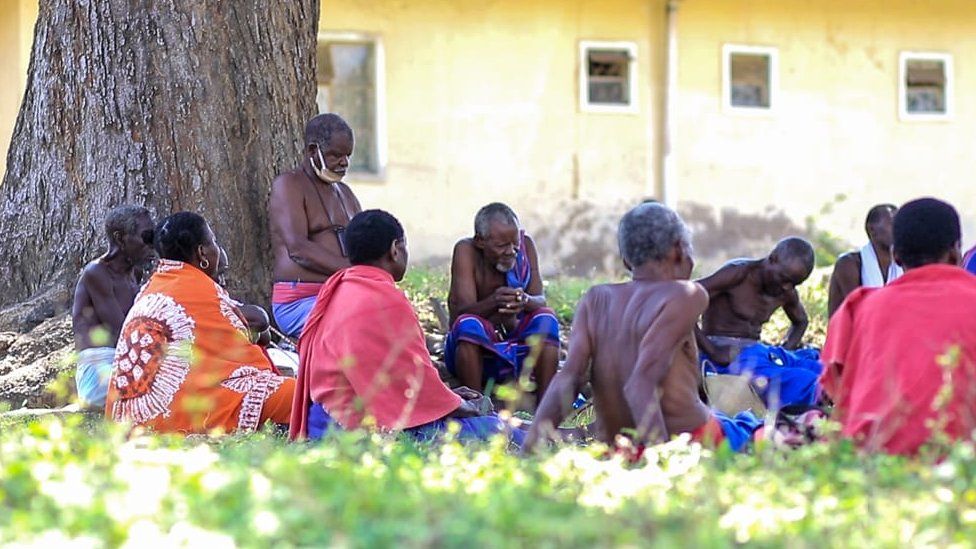
Perhaps unsurprisingly, the mention of any old man's name appears to raise eyebrows. The association of the elderly with sorcery creates fear among some sections of the population.
But the elderly and some of their relatives also live in fear that they might be attacked because of such beliefs.
A few metres from Mr Chisubi's grave in the village lies another one - that of Mwakoyo Dzayo's father, who was killed last year.

Mr Dzayo says his father was killed on suspicion that he was a witchdoctor, an allegation that he denies.
"I have not seen him, not even for a day, as a witchdoctor," he says.
What is being done about it?
The authorities say they have arrested and charged 28 people over the deaths of old men in the area.
However, the outbreak of the Covid-19 pandemic has delayed some of the cases, including that of Mr Chisubi's killing, which is due back in court later in February.
Khamisi Mwaguzo, the programme coordinator of the Kenya Muslim Youth Alliance, has also been trying to get to the bottom of the issue - and says that everyone needs to get involved.

He notes that different groups within the society have been blaming one another for the problems based on religious or cultural differences.
He has been bringing the groups together to teach and reconcile them.
"Some of the Christians say the Kaya [traditional cultural] leaders are devilish, that they are backward people.
"The Kaya people say the religious people are the reason why most of the elders are getting killed," he says.
Mr Mwaguzo says all the groups including Christians, Muslims and the Kaya elders "must come together, preach peace and teach the residents that there is no witchcraft here".
"The young people must learn to earn their own living instead of solely relying on land belonging to their elderly parents," he says.
Land disputes
It is just over a year after Ms Chisubi's husband was killed, and she holds on to the hope that justice will be served.
She does not believe that the death of her husband had anything to do with witchcraft, which he was accused of, but rather a dispute over land inheritance with his brother.
"They had a farm that belonged to their father, all that remained was to get a surveyor so that they share the land," she said.
BBC
"It's the younger people who don't own land and have no decent means of earning their livelihoods who are involved in the crimes.Fred Abuga
Local police commander
Rabai police commander Fred Abuga says land disputes and greed for quick wealth are the primary cause of the killings in the area, according to their investigations.
"The root of all these issues has to do with land. You find that many elderly men own titles to the land.
"It is the younger people who are not involved in land matters, own no land, and have no decent means of earning their daily livelihoods who are involved in the crimes," he says.
'We are not free'
Despite the attempts to deal with the issue, the killings have not abated.
"As we are talking now, one of our elders in Kaya Chonyi [one of the Kaya sub-groups] is lying in the morgue in Kilifi," says Daniel Mwawara Garero, chairman of the local council of elders.
"Even in one of the homesteads here, there is an elderly man who was slaughtered just the other day, so the killings continue and we are living in fear," he says.
Even Ms Chisubi's family is still uneasy over what has transpired since her husband was killed.
"Now he is angry at my children," she says, about her brother-in-law who was freed after denying allegations against him in court. The man who confessed is still in prison awaiting trial.
"We are being asked to leave our land because we talk too much and we don't know what this talking too much is all about.
"We did not report him [to the police], the killer is the one who did.
"We are not free, we are not happy at all," she says.
8 Feb, 2021 13:38
Get short URL
FILE PHOTO: A general view shows Old Bailey central criminal court
in London, Britain, November 25, 2019. © REUTERS / Hannah McKay
A 16-year-old convicted neo-Nazi has avoided prison time in the UK after a court handed down a 24-month youth rehabilitation order at London’s Old Bailey criminal court on Monday.
The child, who can’t be named for legal reasons, pled guilty to 12 offences, including disseminating terrorist documents and possession of terrorist material.
Having gained possession of instructions for building explosives at the age of 13, he went on to collect terrorist material that he shared with other individuals online, as part of far-right chat groups, all from his grandmother’s house in Cornwall.
The boy engaged in the criminal behaviour between 2018 and 2019 and attempted to conceal his identity online. By the summer of 2019, when he was just 14, he had become the British leader of a neo-Nazi cell called the Feuerkrieg Division (FKD).
Established in late 2018, the FKD used online messaging platforms to recruit young members and spread fascist ideology. The group believed that society would eventually break out into racial warfare, allowing them to create a neo-Nazi state.
In 2020 three other members were prosecuted for crimes linked to the group. In February, a counter-terrorism investigation resulted in the confession of an American man who’d considered burning down a synagogue. Later that month a US solider admitted to distributing materials about explosives and weapons of mass destruction. Lithuania police also charged a teenager, believed to be from the group, with planting a bomb, which didn’t detonate, outside an office in Vilnius.
Sentencing the offender, who is now 16, Judge Mark Dennis QC stated that he had “entered an online world of wicked prejudice” that required rehabilitation lest he reoffend and fall into a “spiral of ever-lengthening terms of incarceration”.
Rehabilitation was deemed more effective than a custodial sentence, as the child was viewed as “vulnerable” and having suffered an “abnormal childhood” due to his “restricted and isolated” life.
Taking a wider look at the impact of the case, the judge warned that it revealed a “deeply concerning” picture of “the actions, words and mindset of teenagers.”
Bitcoin Flies To Over $44k After Tesla Purchases $1.5 Billion in BTC
Tesla to accept Bitcoin Payments in the future

Tesla's CEO Elon Musk has been rather vocal about his enthusiasm for cryptocurrency lately, and now, the automaker Tesla has purchased $1.5 billion worth of Bitcoin, according to a new SEC filing. The automaker also stated that it would start accepting Bitcoin payments in the near future, meaning you'll be able to buy a Tesla with just cryptocurrency exchanging hands. Unfortunately, that isn't good news for hardware enthusiasts as it means that demand for other coins, including those mined with GPUs, could intensify, exacerbating the ongoing shortages.
Tesla claims to have bought in this much bitcoin to "to further diversify and maximize returns on our cash" (Section 22 of the SEC filing) -- likely meaning it will sell at least some of the cryptocurrency in the future.
But, curiously, Tesla's move came right before Elon Musk expressed enthusiasm about Bitcoin and Dogecoin on Twitter, which appears to have led both cryptocurrencies to higher prices. As such, Bitcoin is currently at a staggering price of over $44,000 USD, with Dogecoin moving from half a cent to well above 8 cents per coin, a new record high.
Considering the filing is from January, chances are that the $1.5 billion investment has already surpassed $2 billion in value.
That being said, this isn't great news for PC hardware. As Cryptocurrencies become more expensive, mining crypto becomes more profitable and therefore, miners will be willing to pay higher prices for graphics cards, which will only make the shortage worse than it already is. News just broke that Nvidia's RTX 3000 series GPUs are set for concerning shortages in Q1, and this is likely to only make matters worse.
Apple Car not due soon as Apple retreats from Hyundai deal – for now
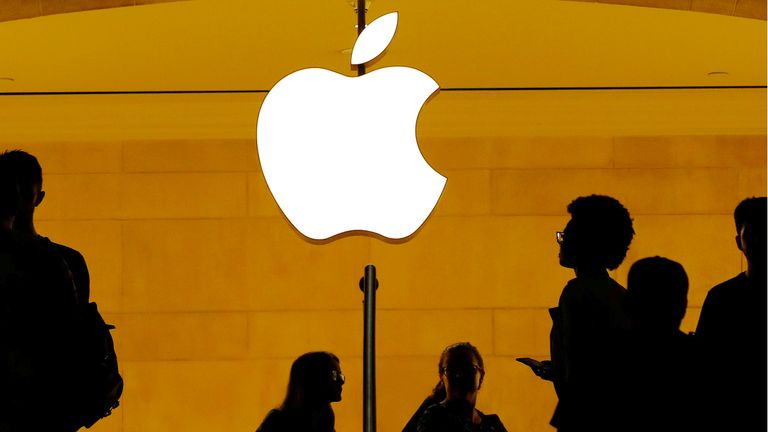
(Image credit: Getty)
BY LUKE WILSON 6 HOURS AGO
Information around the cryptic Apple Car has hit fever-pitch in recent weeks, but it’s now on hold, according to new comments.
Reports now suggest Apple is pushing deals at not just one, but multiple Japanese auto firms that would see the firms lined up under a linear labor model, an approach that has been wildly successful for Apple’s iPhone 12, iPhone 12 Pro, and iPhone 12 Pro Max. This horizontal approach to its supply chain has successfully churned out the latest iPad models, including the Apple iPad Air (2020), en masse to customers but under significant strain to suppliers.
It’s frustrating news for those who were hoping for confirmation of Apple’s take on the automobile following a host of retracted comments and rumors that pointed to a model. That said, we tend to think that any publicity around its products – true or untrue – is grist to Apple's mill.
Talks with Kia to handle manufacturing have now stalled, defying reports that a deal between the two could’ve been struck as early as March (via Bloomberg). Apple had reportedly been eyeing up an eye-watering $3.6 billion investment in Hyundai-owned Kia before subsequently restraining from the rumors
The Japanese news site, Nikkei, reports Apple is actually in talks with multiple Japanese car manufacturers over the Apple Car. It could be a double-edged sword for suppliers that risk being swallowed by Apple’s notoriously demanding supply chain, even demoted to the role of sub-contractor.
Apple is likely to outsource to multiple third parties if it ever develops an Apple Car; therefore, automakers are uncertain about what role they would play long term in what will, undoubtedly, be an enormous project.
Of course, the Cupertino-giant has been historically pegged to many rumors around the autonomous automobile through the Project Titan alias, which would lavish fans with all the bells and whistles of an Apple consumer product, but in a chassis. This is bolstered by the recent hire of Porsche’s Vice President of Chassis Development, Dr Manfred Harrer, who analysts see as a sign of Apple’s ambitions in cars.
If you're already feeling the tinges of the looming cost of such a vehicle, you're not alone. In the interim, you can keep an all-seeing eye on your prized motor with T3's best dash cam of 2021, ever more vital to rendering crisp images of the world outside of your car when on the road.
As is usually the case, there's more to these reports than initially unveiled. The problems in inking a deal seem to lie in the exact details manufacturers will play in the longer-term scope of the project. As this would be Apple's first foray into cars, it's paramount for automakers to map this out before agreeing on a deal. For now, the project rolls onwards.












